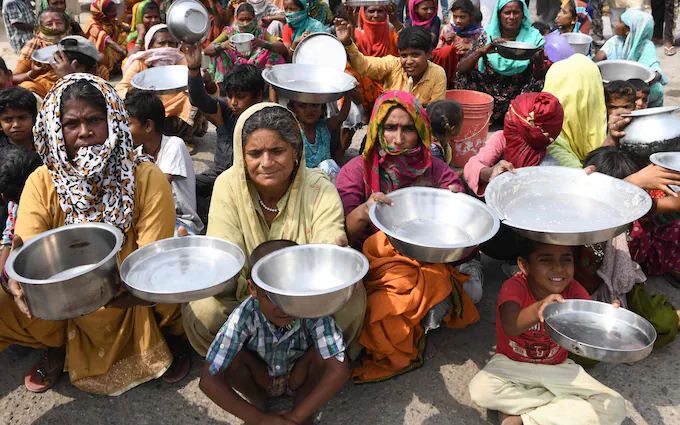
In India, many other food crops and animal fodder crops including wheat, paddy, maize, jowar, bajra, various types of pulses are grown on this arable land. Along with this, India is also among the world’s leading producers in the cultivation of fruits, vegetables, dry fruits, etc. From these facts, it can be easily estimated that there will be no shortage of food for every citizen in India and everyone will get enough food every day, no one will sleep hungry. All children in the country will be born healthy and there will be no problem of malnutrition among children and mothers will also have access to a completely balanced and high-quality diet. But in reality, this is not the case. If we study the data of the World Hunger Report 2024, it is found that in the case of the World Hunger Index (7.8.9.) 2024, India is at number 105 in the survey of 145 countries of the world. India is included in the category of severe hunger along with 42 other countries, out of which 6 countries Burundi, Chad, Madagascar, Somalia, South Sudan and Yemen are in the category of severe hunger. 36 countries including India are in the category of severe hunger. It is worth mentioning that the score of the Global Hunger Index is measured between 100 and 0 (zero), i.e. if this score is high, then the level of hunger will be high and if it is close to zero, then the level of hunger is low. According to the World Hunger Report 2024, if the hunger score is 9.9 or less, then it is called low-level hunger, if the score is between 10.0-19.9, then it is called moderate-level hunger. If this score is between 20.0-34.9, it is severe hunger, if it is between 35.0-49.9, it is very severe hunger, and if this score is 50 or more, it is called severe hunger. While preparing the Global Hunger Index score, several factors are included in it, firstly, such as children and adults not getting enough food, i.e. getting less than the calories they need to stay healthy. Second, the weight loss for their age due to malnutrition in children, thirdly, the weight loss for their height due to malnutrition in children, fourthly, the mortality rate in children under 5 years of age, etc. are also taken into account. The United Nations Sustainable Development Goals include that hunger will be eliminated in the world by 2030, i.e. the score of the Global Hunger Index in the world will be zero.
A study of the Global Hunger Index 2024 score reveals that the 6 countries that are in the severe hunger category have a score ranging from 35 to 50. The 36 countries, including India, that fall in the severe hunger category have a score ranging from 20.6 to 34.9. India’s Global Hunger Index score was 34.4 in 2000, 35.2 in 2008, 29.3 in 2016 and 27.3 in 2024. Although India has made many efforts to reduce hunger during 2000-2024, it has not been as successful as it should have been and during the same period, neighboring countries Bangladesh and Nepal have achieved considerable success in reducing hunger. Now the target date of achieving zero hunger index, the year 2030, is very close. If the trend continues like this, it will take 130 years from now to reach low levels of hunger. The goal of low levels of hunger will also be achieved in 2160, achieving the goal of zero hunger will be a very distant thing. India is among the countries in the world, the southern part of the Sahara (Saharan) Africa and South Asia, where the situation of hunger is at a terrible level. In these regions, indicators affecting hunger such as not getting full food to children, malnutrition, high mortality rate of children under 5 years of age, etc. are being found at very high levels. This World Hunger Report also mentions some of the main difficulties and obstacles to reducing and eradicating hunger in the world, which include armed conflicts, riots and conflicts, environmental pollution and inhuman changes in the environment, high prices in domestic food markets, distortions by market forces in the grain market, major weaknesses in the financial and economic conditions of the people and the debt trap of most poor and middle-income countries, etc. The report makes it clear that during the period 2000-2016, all the countries suffering from hunger in the world made great efforts and achieved great successes to reduce hunger. Many of those countries were suffering from extreme levels of hunger and their hunger index score was more than 50, during this period they had reduced this score to less than 30. But after 2016, India, the world’s most hungry country, has not made much progress in this regard, because the global hunger index score, which was 18.8 in 2016, has only reached 18.3 with a slight decrease in 2024. During this time, India’s score has not improved much and has decreased from 29.3 to only 27.3. Although India’s hunger index score has continuously decreased since 2000, it is a matter of concern that even today 33 percent of children are underweight for their age due to malnutrition, 20 percent of children are short in height due to malnutrition and about 77 percent of children, in many states more than 80 percent, are deprived of the nutritious diet recommended by the World Health Organization.








